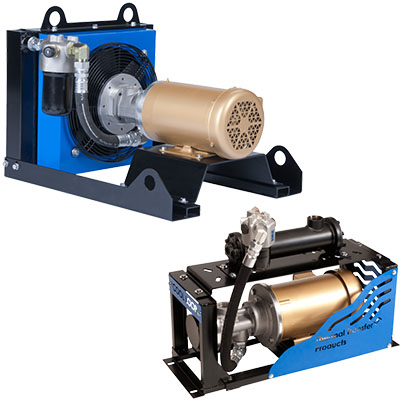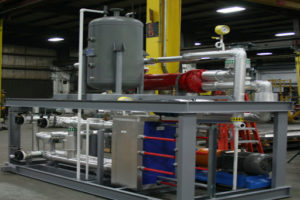Five Techniques DVS Heat Transfer Systems Improve Energy Management in Manufacturing
Wiki Article
Innovations in Heat Transfer Systems: What You Need to Know for Optimal Efficiency
Innovations in Heat transfer systems are changing performance throughout different markets. Advanced products like graphene and nanofluids guarantee substantial renovations in thermal conductivity. The integration of IoT and equipment learning supplies chances for real-time surveillance and boosted power efficiency. However, the landscape of thermal monitoring is quickly evolving (DVS Heat Transfer Systems). Recognizing these developments is important for attaining optimal system efficiency and sustainability in the future. What details innovations are forming this improvement?Emerging Materials for Improved Heat Transfer

Advanced Heat Exchanger Styles
While typical Heat exchangers have served their function in various applications, progressed styles are currently arising to satisfy the increasing demands for efficiency and performance. These innovative styles, such as plate, shell-and-tube, and finned-tube Heat exchangers, incorporate enhanced surface areas and improved circulation patterns to raise thermal transfer prices. On top of that, compact layouts enable minimized space requirements without jeopardizing performance. Advanced materials, such as composites and corrosion-resistant alloys, furthermore improve durability and efficiency under extreme problems. Additionally, simulation technologies and computational liquid dynamics are increasingly used to refine these layouts, ensuring peak Heat transfer attributes. As markets seek to reduce energy intake and maximize output, the adoption of sophisticated Heat exchanger designs is crucial in accomplishing these objectives.The Duty of Nanotechnology in Heat Transfer
Nanotechnology plays an important role in enhancing thermal conductivity within Heat transfer systems. By manipulating materials at the nanoscale, researchers have achieved considerable enhancements in energy performance. These developments not only maximize performance but also add to even more lasting energy services.Enhanced Thermal Conductivity
Considerable developments in thermal conductivity have actually emerged via the application of nanotechnology, revolutionizing Heat transfer systems across various industries. By integrating nanoparticles into Heat transfer liquids and materials, scientists have achieved exceptional rises in thermal conductivity. These nanoparticles, such as carbon nanotubes, graphene, and steel oxides, boost the Heat transfer buildings as a result of their high surface and unique thermal qualities. The resulting compounds show enhanced efficiency in applications varying from electronics cooling systems to renewable resource innovations. Moreover, the capacity to tailor the size, form, and composition of nanoparticles permits maximized thermal administration options. Therefore, nanotechnology remains to play an essential role in the growth of a lot more reliable and effective Heat transfer systems, leading the way for improved commercial applications.
Power Effectiveness Improvements

Combination of IoT in Heat Transfer Systems
The assimilation of IoT in Heat transfer systems presents the application of wise sensing units that improve functional effectiveness. These sensing units allow real-time information monitoring, permitting instant changes and optimizations. This technological innovation has the potential to considerably improve performance and energy monitoring in Heat transfer applications.Smart Sensors Application
As Heat transfer systems advance, the assimilation of clever sensors through the Net of Things (IoT) has emerged as a transformative strategy. These sensors allow real-time tracking of pressure, circulation, and temperature level prices, boosting system effectiveness and integrity. By collecting and transmitting data, they promote proactive upkeep, reducing the threat of system failings. Furthermore, clever sensors add to power cost savings by refining operational specifications based upon environmental conditions. Their ability to assess anomalies and trends enables for notified decision-making, guaranteeing peak performance of Heat transfer systems. As sectors significantly embrace this technology, the execution of wise sensors stands to change exactly how Heat transfer systems are handled, leading the way for better sustainability and improved performance outcomes.Real-Time Data Monitoring
Just how can real-time information keeping track of enhance the efficiency of Heat transfer systems? By integrating Web of Things (IoT) innovation, Heat transfer systems can take advantage of continuous data collection from wise sensors. This real-time monitoring enables instant evaluation of temperature level, stress, and circulation prices, enabling operators to recognize inadequacies immediately. Changes can be made to maximize performance, decrease power intake, and extend devices life-span. Additionally, predictive upkeep can be carried out, decreasing unanticipated downtime and pricey repairs. The capability to picture efficiency metrics through dashboards improves decision-making, fostering a proactive method to system administration. Eventually, real-time information keeping an eye on not only enhances operational check out here effectiveness but also adds to sustainability objectives within commercial processes.Energy Efficiency and Sustainability Trends
Power effectiveness and sustainability patterns are improving the landscape of Heat transfer systems, driving innovation and compliance across numerous markets. Organizations are significantly focusing on energy-efficient layouts to lower functional expenses and lessen environmental impacts. The combination of renewable resource sources is coming to be much more widespread, allowing Heat transfer systems to operate sustainably while satisfying regulative requirements. Additionally, advancements in modern technologies and materials advertise reduced energy consumption click resources and enhance general performance. Lifecycle analyses are additionally gaining traction, permitting firms to examine the ecological impact of Heat transfer systems from manufacturing to disposal. This concentrate on sustainability not just sustains company responsibility however likewise positions organizations competitively in a market where customers significantly prefer environment-friendly options. Subsequently, energy efficiency and sustainability stay essential considerations for future growths in Heat transfer technology.Advancements in Thermal Management Solutions
While the demand for efficient Heat transfer proceeds to increase, innovations in thermal monitoring remedies are emerging to attend to both performance and sustainability difficulties. Advanced materials, such as stage change products and nanofluids, are being established to enhance Heat transfer effectiveness - DVS Heat Transfer Systems. These materials boost thermal conductivity and enable far better temperature level policy in browse around these guys numerous applications. In addition, innovations like active thermal control systems are obtaining traction, allowing real-time changes to take care of Heat flow efficiently. These systems add to power financial savings and reduce the ecological effect of thermal processes. Moreover, the combination of IoT in thermal management facilitates tracking and predictive maintenance, guaranteeing enhanced efficiency and longevity of Heat transfer systems. On the whole, these innovations represent significant strides toward more sustainable thermal management practicesFuture Directions in Heat Transfer Innovation
Emerging innovations in thermal management options indicate a promising future for Heat transfer innovation. Researchers are progressively concentrating on establishing materials with premium thermal conductivity and improved power effectiveness. Developments such as nanofluids, which have put on hold nanoparticles, supply significant renovations in Heat transfer performance. Additionally, the combination of wise materials that adjust to varying temperature problems is gaining traction, permitting for more receptive and efficient systems. The rise of additive manufacturing strategies is likewise allowing the design of complicated Heat exchanger geometries that enhance liquid circulation. In addition, the execution of artificial intelligence formulas is anticipated to revolutionize the optimization of Heat transfer systems, facilitating predictive maintenance and performance enhancement. Collectively, these improvements are poised to change the landscape of Heat transfer innovations in different industries.
Frequently Asked Questions

How Do I Select the Right Heat Transfer System for My Application?
Selecting the appropriate Heat transfer system entails assessing application demands, including temperature level arrays, liquid homes, and performance requirements. Evaluating system kinds, maintenance considerations, and cost-effectiveness additionally plays an essential role in making an informed choice.What Are the Maintenance Demands for Advanced Heat Exchangers?
Upkeep requirements for innovative Heat exchangers usually consist of routine assessments, monitoring for leaks, cleansing of surfaces, and guaranteeing suitable circulation rates. Sticking to producer guidelines warranties efficient operation and lengthens the equipment's life expectancy.
Just How Do Ecological Variables Influence Heat Transfer Performance?
Environmental factors substantially influence Heat transfer performance. Variations in temperature, airflow, and humidity impact thermal conductivity and convective Heat transfer, inevitably impacting system performance and necessitating factor to consider during the design and operation of Heat transfer systems.What Safety And Security Requirements Put On Heat Transfer Solutions?
Security requirements for Heat transfer systems normally include guidelines from organizations such as ASME and ASTM. DVS Heat Transfer Systems. These requirements address products, style, and operational techniques to assure reliability, efficiency, and defense versus risks in numerous applications
How Can I Fix Usual Heat Transfer System Issues?
Troubleshooting typical Heat transfer system concerns involves examining for leaks, making sure proper fluid circulation, examining insulation honesty, and confirming temperature differentials. Determining these aspects can aid maintain system effectiveness and protect against further problems.Nanotechnology plays a necessary function in enhancing thermal conductivity within Heat transfer systems. Significant innovations in thermal conductivity have actually emerged with the application of nanotechnology, reinventing Heat transfer systems across different sectors. Innovations in thermal conductivity through nanotechnology have paved the method for amazing improvements in power efficiency within Heat transfer systems. Power performance and sustainability patterns are improving the landscape of Heat transfer systems, driving technology and compliance throughout different industries. The integration of IoT in thermal management assists in surveillance and anticipating maintenance, making sure enhanced efficiency and long life of Heat transfer systems.
Report this wiki page